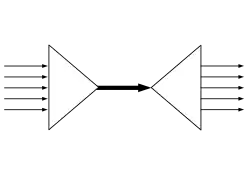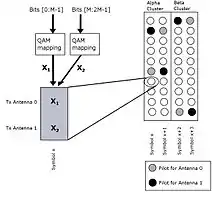Spatial multiplexing
Spatial multiplexing or space-division multiplexing (often abbreviated SM, SDM or SMX) is a multiplexing technique in MIMO wireless communication, fibre-optic communication and other communications technologies used to transmit independent channels separated in space. Other multiplexing techniques include FDM (frequency-division multiplexing), TDM (time-division multiplexing) or PDM (polarization-division multiplexing).
| Multiplexing |
|---|
 |
| Analog modulation |
|
Statistical multiplexing (variable bandwidth) |
| Related topics |


Fibre-optic communication
In fibre-optic communication SDM refers to the usage of the transverse dimension of the fibre to separate the channels.
Multi-core fibre (MCF)
Multi-core fibres are fibres designed with more than a single core.
Mode-division multiplexing (MDM)
Mode-division multiplexing utilizes the transverse spatial modes of the fibre to separate the channels.
Fibre bundles
Bundled fibres are also considered a form of SDM, these are massive number of fibres bundled tightly together.
Wireless communications
If the transmitter is equipped with antennas and the receiver has antennas, the maximum spatial multiplexing order (the number of streams) is,
if a linear receiver is used. This means that streams can be transmitted in parallel, ideally leading to an increase of the spectral efficiency (the number of bits per second per Hz that can be transmitted over the wireless channel). The practical multiplexing gain can be limited by spatial correlation, which means that some of the parallel streams may have very weak channel gains.
Open-loop approach
In an open-loop MIMO system with transmitter antennas and receiver antennas, the input-output relationship can be described as
where is the vector of transmitted symbols, are the vectors of received symbols and noise respectively and is the matrix of channel coefficients. An often encountered problem in open loop spatial multiplexing is to guard against instance of high channel correlation and strong power imbalances between the multiple streams. One such extension which is being considered for DVB-NGH systems is the so-called enhanced Spatial Multiplexing (eSM) scheme.
Closed-loop approach
A closed-loop MIMO system utilizes Channel State Information (CSI) at the transmitter. In most cases, only partial CSI is available at the transmitter because of the limitations of the feedback channel. In a closed-loop MIMO system the input-output relationship with a closed-loop approach can be described as
where is the vector of transmitted symbols, are the vectors of received symbols and noise respectively, is the matrix of channel coefficients and is the linear precoding matrix.
A precoding matrix is used to precode the symbols in the vector to enhance the performance. The column dimension of can be selected smaller than which is useful if the system requires streams because of several reasons. Examples of the reasons are as follows: either the rank of the MIMO channel or the number of receiver antennas is smaller than the number of transmit antennas.
